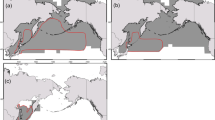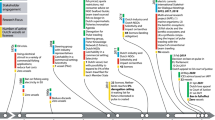Abstract
Hairtail (Trichiurus lepturus) has been traditionally harvested by multi-gear types in the Yellow Sea and the East China Sea, except for the East Sea (Sea of Japan) in Korean waters. Six different fishery types such as offshore stownet fishery, offshore longline fishery, large pair-trawl fishery, large purse seine fishery, large otter trawl fishery and offshore angling fishery target to harvest the hairtail stock accounting for about 90% of the total annual catch. We attempted to develop an ecosystem-based fisheries assessment approach, which determines the optimal allocation of catch quotas and fishing efforts for major fisheries. We conducted standardization of fishing effort for six types of hairtail fisheries using a general linear model (GLM), and then estimated maximum sustainable yield (MSY) and maximum economic yield (MEY). Estimated MSY and MEY for the hairtail stock were estimated as 100,151 mt and 97,485 mt, respectively. In addition, we carried out an ecosystem-based risk analysis to obtain species risk index (SRI), which was applied to adjusting the optimal proportion of fishing effort for six hairtail fisheries as a penalty or an incentive. As a result, fishing effort ratios were adjusted by SRI for the six fisheries types. Also, the total allowable catch (TAC) was estimated as 97,485 mt and the maximum net profit at TAC by the hairtail fisheries was estimated as 778 billion won (USD 765 million).
Similar content being viewed by others
References
Chyung MK (1977) The Fishes of Korea. Ii Ji Sa, Seoul, 731 p (in Korean)
FAO (Food and Agriculture Organization of the United Nations) (2003) The ecosystem approach to Fisheries. FAO, Rome, Technical guidelines for responsible fisheries No. 6, Suppl. 2, 112 p
Fox WW (1970) An exponential surplus yield model for optimizing exploited fish populations. T Am Fish Soc 99(99):80–88
Lee JU (1991) Estimation on optimum fishing effort of walleye pollock fishery in the east coast of Korea: based on the economic analysis between danish seine fishery and trawl fishery for walleye pollock. J Fish Bus Admin 22:75–99 (in Korean)
MAFF (Ministry of Agriculture, Forestry and Fisheries) (1980–2006) Statistical yearbook of agriculture, forestry and fisheries. MAFF, Seoul (in Korean)
MIFAFF (Ministry for Food, Agriculture, Forestry and Fisheries) (2008–2012) Statistical yearbook of food, agriculture, forestry and fisheries. MIFAFF, Seoul (in Korean)
MMAF (Ministry of Maritime Affairs and Fisheries) (1997–2007) Statistical yearbook of maritime affairs and fisheries. MMAF, Seoul (in Korean)
NARK (National Assembly of the Republic of Korea) (2014) Enforcement ordinance for fisherieslaw. NARK, Seoul (in Korean)
NFFC (National Federation of Fisheries Cooperatives) (1980–2012) Report of fishery management research. NFFC, Seoul (in Korean)
Quinn TJ, Deriso RB (1999) Quantitative fish dynamics. University of Oxford, USA, 542 p
Seo YI, Zhang CI (2001) A study on the multi-gear and multispecies fisheries assessment models in Korean waters. J Korean Fish Soc 34(34):359–364 (in Korean)
UNCSD (United Nations Conference on Environmental Development) (2012) Rio+20 declaration: The Future We Want. http://www.unsd2012.org/thefuturewewant.html
WSSD (World Summit on Sustainable Development) (2002) Plan of Implementation. WSSD. United Nations, New York
Yoon SC (2014) Characteristics of Korean coastal fisheries and ecosystem-based resource assessment. Ph.D. Thesis, Pukyong National University, Busan, 226 p
Zhang CI, Kim S, Gunderson D, Marasco R, Lee JB, Park HW, Lee JH (2009) An ecosystem-based fisheries assessment approach for Korean fisheries. Fish Res 100:26–41
Zhang CI, Park HW, Lim JH, Kwon HC, Kim DH (2010) A study on indicators and reference points for the ecosystem-based resource assessment. J Korean Soc Fish Tech 46(46):32–49 (in Korean)
Zhang CI, Lee JB (2001) Stock assessment and management implications of horse mackerel (Trachurus japonicus) in Korean waters, based on the relationships between recruitment and the ocean environment. Prog Oceanogr 49:513–537
Author information
Authors and Affiliations
Corresponding author
Rights and permissions
About this article
Cite this article
Kang, H.J., Zhang, C.I., Lee, E.J. et al. An ecosystem-based assessment of hairtail (Trichiurus lepturus) harvested by multi-gears and management implications in Korean waters. Ocean Sci. J. 50, 237–250 (2015). https://doi.org/10.1007/s12601-015-0021-5
Received:
Revised:
Accepted:
Published:
Issue Date:
DOI: https://doi.org/10.1007/s12601-015-0021-5




